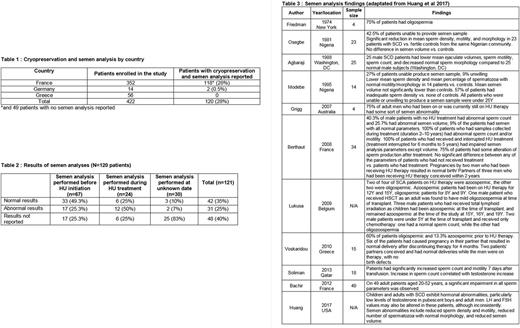Abstract
Background
Hydroxycarbamide (hydroxyurea or HU) is an orphan medicinal product for the prevention of recurrent vaso-occlusive crises and acute chest syndrome in adults (US and Europe) and children older than 2 years (Europe) with sickle-cell disease (SCD).
HU is generally well tolerated; however, it could have adverse effects on male fertility. Despite the fact that male fertility issues such as delayed puberty, sperm abnormalities and low testosterone level could be directly linked to the underlying SCD, thorough patient information and if it is possible, cryopreservation are recommended before starting HU. It has been demonstrated in a prospective comparison of sperm parameters in SCD adult patients before and after a 6 months treatment with hydroxyurea, impairment in sperm parameters (Bachir et al, 2012).
ESCORT-HU (European Sickle Cell Disease Cohort-Hydroxyurea) is a European multicenter, prospective, non-interventional study initiated in Europe to collect more information about the safety profile and morbidity-mortality in SCD patients treated with Siklos® (HU). Our purpose in the present study was to verify whether recommendations regarding male fertility are really implemented and if cryopreservation is a common process in Europe through the preliminary results of ESCORT-HU study.
Methods and patients
The data used were from ESCORT-HU study. The cut-off date of data extraction was set as June 19th, 2017. Between January 2009 to June 2017, 1841 patients were enrolled from 63 centers in France, Germany, Greece and Italy. For this analysis only data (age, cryopreservation, sperm analysis results) from male patient were analyzed, no male patient has been excluded. 824 male-patients were aged 0.7 to 78 years at the time of study initiation among which 422 had reached puberty (>15 years of age), with a mean age of 31 years. The main hemoglobin genotype was SS (336 patients), followed by Sß+ (28 patients) and Sß0 (31 patients).
Results
On the 422 patients aged 15 years and older, 170 cryopreservations (169 patients) have been reported, among them 121 semen analyses have been recorded. The mean age for performing these examinations was 30 years. Cryopreservations realized systematically with a sperm analysis were mainly performed in France, in contrary to Germany where only children were enrolled and moreover cryopreservations were not supported (Table 1).
Before initiation of a treatment with HU, 67 sperms analysis (66 patients) were performed and 50 results (49 patients) were reported. Among them, 33 results (49%) were considered normal and 17 (25%) with abnormalities (at least 1 abnormal criterion: sperm mobility, sperm count, appearance).
During HU treatment, 24 sperms analyses (24 patients) were performed and a result was reported for 18 of them. The rate of abnormalities during HU treatment increased to 50% (12 abnormal sperms analysis). Reported abnormalities were asthenospermia, hypospermia, oligospermia, azoospermia and atypical forms (Table 2).
Conclusion
There were no patients with sperms analysis performed before and during the treatment in order to compare the results in our database.
These results confirm information reported in a recent review (Table 3) about abnormalities include reduced sperm density and motility, reduced number of spermatozoa with normal morphology, and reduced semen volume.
Intensification with HU during childhood might change these related-disease events however HU is itself deleterious for the sperm cells. Therefore, male fertility assessment before any HU therapy but also during the treatment should be carried out. Cryopreservation may be very useful if the resolution of HU-induced lesions is prolonged and if the patient wishes to become father.
Ribeil: Novartis: Other: Non-financial support; Addmedica: Membership on an entity's Board of Directors or advisory committees; Vitalaire: Other: Non-financial support. Bartolucci: Fondation Fabre: Research Funding; Addmedica: Research Funding; Novartis US: Membership on an entity's Board of Directors or advisory committees; GBT: Membership on an entity's Board of Directors or advisory committees. Galacteros: Addmedica: Membership on an entity's Board of Directors or advisory committees.
Author notes
Asterisk with author names denotes non-ASH members.


